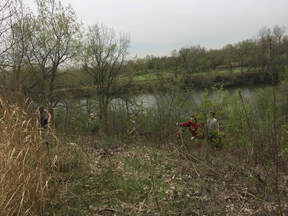|
This post is the second in a set of guest posts by students in my Biology 100 class who helped manage an area of Lake Katherine for one of our lab sessions. It was a breezy Thursday afternoon at the end of April. A little bit above 70 degrees, sun shining partly through the clouds. If you ask me, our biology classes’ trip to Lake Katherine could not have been planned for a better day. Lake Katherine is located directly across the street from Trinity Christian College, where for the past few weeks, my fellow classmates and I have been studying ecology and environmental stewardship. I had previously heard of Lake Katherine, but I had never had the opportunity to visit there before. That being said, this trip was particularly special for me in this aspect because I got to see a part of God’s beautiful creation that I had never seen before, while applying the information that we learned in class to the real world. When we arrived at Lake Katherine, we took a series of turns through the forest area until we arrived at the lake itself, where we were greeted by one of the naturalists that works on the property. She told us that we would be helping to cut down buckthorn plants using a tool called a lopper. At Lake Katherine, buckthorn plants are referred to as an invasive species because they are not native to the area. If an invasive species is allowed to grow in an area that it is not native to, the native species will be prevented from growing. After we were told these instructions, each of us put on our gloves, grabbed a lopper, and got to work. After working for about an hour and a half, we had each removed several buckthorn plants. This means that the native species of Lake Katherine will be able to grow in the coming months. Through removing the buckthorn plants, our class participated in the ecological restoration of Lake Katherine, which was affected by a disturbance many years ago. Besides actively participating in the ecological restoration of Lake Katherine, our biology class got to experience and learn more about environmental stewardship. As human beings, we play a huge role in God’s creation. The earth was so graciously given to us by God, therefore human beings should reciprocate by preserving the earth’s wonderful beauty by using all of the available resources that we have. By removing the invasive species of buckthorn plant using the loppers that were given to us, our biology class was able to preserve the native species of Lake Katherine, and in the coming months, it will be able to flourish beautifully for hundreds of visitors to see. ~Allison Hrechko
0 Comments
Leave a Reply. |
Abbie SchrotenboerI'm a biology professor at Trinity Christian College. I'll be using this page to share interesting stories related to ecology and conservation at Trinity and in the Chicago area (although I might be tempted to expand my geographic focus upon occasion). Archives
December 2020
Categories |


 RSS Feed
RSS Feed
